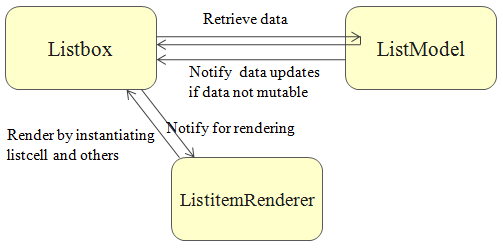List Model"
| Line 37: | Line 37: | ||
private List _data; | private List _data; | ||
public int getSize() { | public int getSize() { | ||
| − | //load data into _data | + | //load all data into _data |
return _data.size(); | return _data.size(); | ||
} | } | ||
Revision as of 10:14, 29 December 2010
Listbox and Grid allow developer to separate the view and the model by implementing ListModel. Once the model is assigned (with Listbox.setModel(ListModel)), the display of the listbox is controlled by the model, and an optional renderer. The model is used to provide data, while the renderer is used to provide the custom look. By default, the data is shown as a single-column grid/listbox. If it is not what you want, please refer to the View section for writing a custom renderer.
Model-driven Display
As shown, listbox retrieves items from the specified model[1], and then invokes the renderer, if specified, to compose the listitem for the item.
The retrieval of items is done by invoking ListModel.getSize() and ListModel.getElementAt(int).
The listbox will register itself as a data listener to the list model by invoking ListModel.addListDataListener(ListDataListener) Thus, if the list model is not mutable, the implementation has to notify all registered data listener. It is generally suggested to extend from AbstractListModel which provides a set of utilities for handling data listeners. Then, you need to only implement ListModel.getSize() and ListModel.getElementAt(int).
- ↑ The listbox is smart enough to read the items that are visible at the client, such the items for the active page. It is called Live Data or Render on Demand'.'
Small Amount of Data
If your data can be represented as a list, map, set or array (java.util.List, java.util.Map, etc.), you could use one of the default implementations, such as ListModelList, ListModelMap, ListModelSet and ListModelArray. For example,
void setModel(List data) {
listbox.setModel(new ListModelList(data));
}
If the amount of your data is small, you could load them all into a list, map, set or array. Then, you could use one of the default implementations as described above.
Alternatively, you could load all data when ListModel.getSize() is called. For example,
public class FooModel extends AbstractListModel {
private List _data;
public int getSize() {
//load all data into _data
return _data.size();
}
public Object getElementAt(int index) {
return _data.get(index);
}
}
Hug Amount of Data
Version History
| Version | Date | Content |
|---|---|---|
